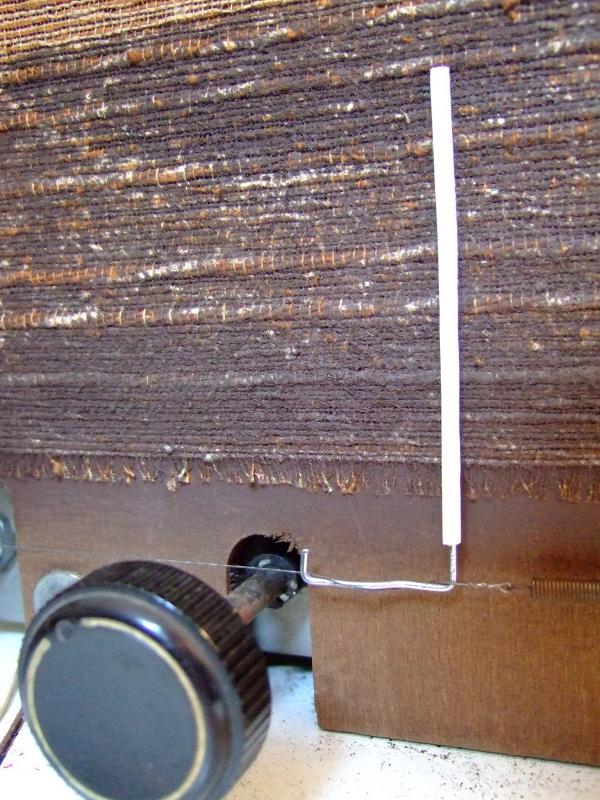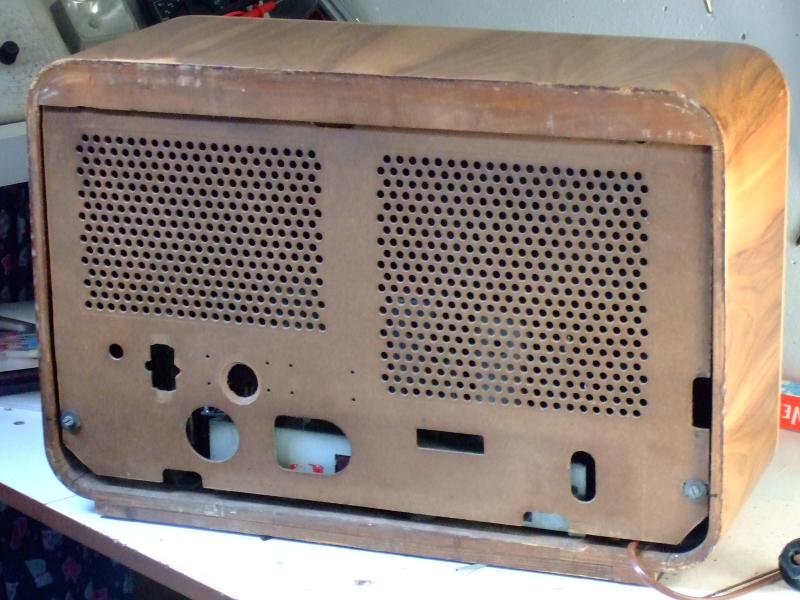
356
Item nr.

Tesla Romance Table top
Slovak set with rare EF22
Data for Tesla Romance
| Production | Czechoslovakia, 1949.
|
|---|
| Bands | LMS. |
|---|
| Tubes | ECH21, EF22, EF22, EBL21, EM11, AZ11. |
|---|
| Cabinet | Wood.
Size 50x34x20cm.
|
|---|
| Power | AC 55W. |
|---|
| Documents | Schema and site. |
|---|
The Design
The EF22 tube isn't seen very often. But it turns out that Tesla has several sets using two of them, one as IF amplifier and one as AF amplifier.
| Obtained | 5/2013
from Marian Andrejko. |
|---|
| Condition | 6. |
|---|
| Disposed | Sold 10/2013. |
|---|
| Sound sample | PLAY SOUND Que sera sera..: Wat de toekomst brengen moge. |
|---|
This Object
In May 2013 I visited Kosice for the 50th Anniversary of the Faculty of Science.  At that occasion, Marian gave me this radio. Only the dial was missing, and the back panel. It is usually not very hard to make such sets play again, but without proper dial the radio will not be as it was designed.
At that occasion, Marian gave me this radio. Only the dial was missing, and the back panel. It is usually not very hard to make such sets play again, but without proper dial the radio will not be as it was designed.

 It was a bit dusty inside and the ECH21 was white, indicating a loss of vacuum. I changed the ECH21 and it turned out the radio gave a good and clear sound already, so it would be worthwhile to repair and varnish it completely.
It was a bit dusty inside and the ECH21 was white, indicating a loss of vacuum. I changed the ECH21 and it turned out the radio gave a good and clear sound already, so it would be worthwhile to repair and varnish it completely.

 Measurements revealed that the B+ was very low (about 100V) and that B- was absent, so the EBL21 ran without bias. I managed to correct the B- circuitry, but due to a worn out AZ11, the current through the output tube was too low to produce full B- of 6V. Obviously this was because of a bad rectifier AZ11. At the NVHR swap meeting I purchased a Stahlhelm, steel tube wit 11-type base, with the idea to fit two diodes in it. But I could not open the tube. However, just pointing the diode leads in the tube socket also works fine.
Measurements revealed that the B+ was very low (about 100V) and that B- was absent, so the EBL21 ran without bias. I managed to correct the B- circuitry, but due to a worn out AZ11, the current through the output tube was too low to produce full B- of 6V. Obviously this was because of a bad rectifier AZ11. At the NVHR swap meeting I purchased a Stahlhelm, steel tube wit 11-type base, with the idea to fit two diodes in it. But I could not open the tube. However, just pointing the diode leads in the tube socket also works fine.
 What to do about the lack of a dial? In my part store I found just one dial, once part of a Philips B3X32A, which had the exact size as the missing Tesla dial. So I figured that most dials would have about this size, and put a dial on my shopping list for the NVHR Swap Meet. Replacing the dial pointer was doable with a paper clip and some wire isolation (right). Unfortunately, no dial in the appropriate size was available at the market! So I put the Tesla back together with the Philips dial, whose printing is complete nonsense compared with the Tesla operation.
What to do about the lack of a dial? In my part store I found just one dial, once part of a Philips B3X32A, which had the exact size as the missing Tesla dial. So I figured that most dials would have about this size, and put a dial on my shopping list for the NVHR Swap Meet. Replacing the dial pointer was doable with a paper clip and some wire isolation (right). Unfortunately, no dial in the appropriate size was available at the market! So I put the Tesla back together with the Philips dial, whose printing is complete nonsense compared with the Tesla operation.

 Strangely, the power transformer is not mounted on the chassis but directly on the wood bottom of the cabinet. I replaced the wiring connecting the two parts. To replace the back I found a Philips back that looks quite neat on the set.
Strangely, the power transformer is not mounted on the chassis but directly on the wood bottom of the cabinet. I replaced the wiring connecting the two parts. To replace the back I found a Philips back that looks quite neat on the set.
Part of Gerard's Radio Corner.
Generated by SiteBuilder on
6/9/2025
by Gerard

 Measurements revealed that the B+ was very low (about 100V) and that B- was absent, so the EBL21 ran without bias. I managed to correct the B- circuitry, but due to a worn out AZ11, the current through the output tube was too low to produce full B- of 6V. Obviously this was because of a bad rectifier AZ11. At the NVHR swap meeting I purchased a Stahlhelm, steel tube wit 11-type base, with the idea to fit two diodes in it. But I could not open the tube. However, just pointing the diode leads in the tube socket also works fine.
Measurements revealed that the B+ was very low (about 100V) and that B- was absent, so the EBL21 ran without bias. I managed to correct the B- circuitry, but due to a worn out AZ11, the current through the output tube was too low to produce full B- of 6V. Obviously this was because of a bad rectifier AZ11. At the NVHR swap meeting I purchased a Stahlhelm, steel tube wit 11-type base, with the idea to fit two diodes in it. But I could not open the tube. However, just pointing the diode leads in the tube socket also works fine.  What to do about the lack of a dial? In my part store I found just one dial, once part of a Philips B3X32A, which had the exact size as the missing Tesla dial. So I figured that most dials would have about this size, and put a dial on my shopping list for the NVHR Swap Meet. Replacing the dial pointer was doable with a paper clip and some wire isolation (right). Unfortunately, no dial in the appropriate size was available at the market! So I put the Tesla back together with the Philips dial, whose printing is complete nonsense compared with the Tesla operation.
What to do about the lack of a dial? In my part store I found just one dial, once part of a Philips B3X32A, which had the exact size as the missing Tesla dial. So I figured that most dials would have about this size, and put a dial on my shopping list for the NVHR Swap Meet. Replacing the dial pointer was doable with a paper clip and some wire isolation (right). Unfortunately, no dial in the appropriate size was available at the market! So I put the Tesla back together with the Philips dial, whose printing is complete nonsense compared with the Tesla operation.

 At that occasion, Marian gave me this radio. Only the dial was missing, and the back panel. It is usually not very hard to make such sets play again, but without proper dial the radio will not be as it was designed.
At that occasion, Marian gave me this radio. Only the dial was missing, and the back panel. It is usually not very hard to make such sets play again, but without proper dial the radio will not be as it was designed. 
 It was a bit dusty inside and the ECH21 was white, indicating a loss of vacuum. I changed the ECH21 and it turned out the radio gave a good and clear sound already, so it would be worthwhile to repair and varnish it completely.
It was a bit dusty inside and the ECH21 was white, indicating a loss of vacuum. I changed the ECH21 and it turned out the radio gave a good and clear sound already, so it would be worthwhile to repair and varnish it completely. 
 Strangely, the power transformer is not mounted on the chassis but directly on the wood bottom of the cabinet. I replaced the wiring connecting the two parts. To replace the back I found a Philips back that looks quite neat on the set.
Strangely, the power transformer is not mounted on the chassis but directly on the wood bottom of the cabinet. I replaced the wiring connecting the two parts. To replace the back I found a Philips back that looks quite neat on the set.